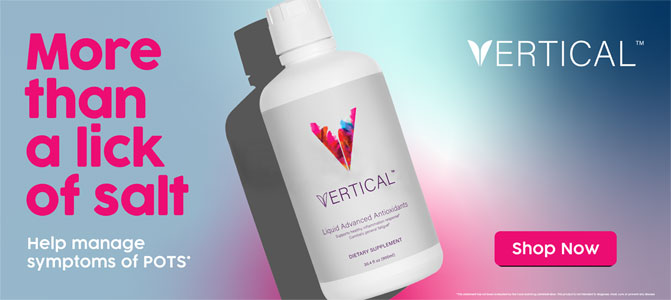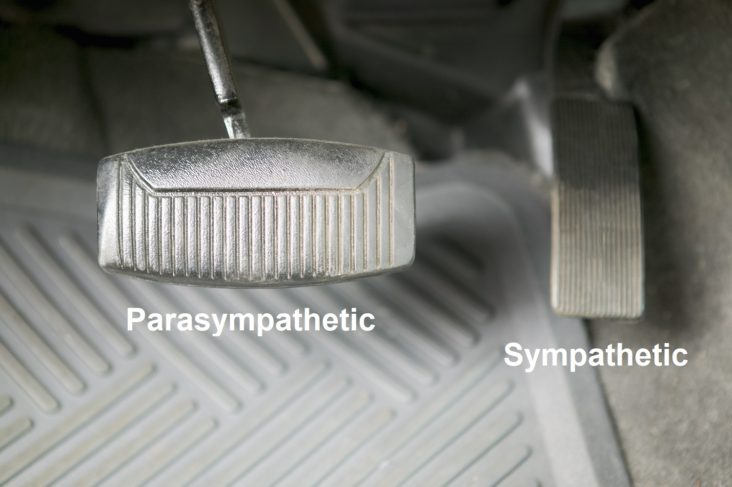Click here to download this post
OVERACTIVE SYMPATHETIC NERVOUS SYSTEM
The autonomic nervous system is one of the three main portions of your entire nervous system. The autonomic nervous system is the portion that controls or coordinates all organs and virtually all cells of your body. The autonomic nervous system itself consists of two parts: the sympathetic nervous system and the parasympathetic nervous system. The sympathetic nervous system, which is like the accelerator of the body, is known as the flight or fight nervous system and deals with stress, typically speeding things up. The parasympathetic nervous system, which is like the brakes of the body, is known as the rest and digest nervous system and helps to conserve energy and protect, typically slowing things down.

Again, like an automobile, the autonomic nervous system has divisions which can speed up or slow down various functions of the body. The sympathetics typically increase heart rate and blood pressure to pump more blood to deal with stress; and dilates pupils to see more, bronchi to inhale more oxygen, and peripheral blood vessels to bring more blood to the muscles. The parasympathetic nervous system does the opposite. If the sympathetic system, like the accelerator of a car, becomes over-reactive it may actually damage the other component of the autonomic nervous system, the parasympathetic nervous system. In the car analogy, this is like driving fast all the time and therefore, having to stop hard all the time. Doing this you wear out the brakes faster. The problem in the human body is that we cannot replace the “brakes” (the parasympathetics). Once the Parasympathetics wear out you are essentially a heart attack waiting to happen.
Even if both are worn, if the parasympathetics are significantly more worn, the sympathetics may still be too high; in comparison. It is the ratio  between the two (SB = S/P, known as Sympathovagal Balance) that is the key. Again with the car analogy, even if you have no brakes and no accelerator (you are very old or very sick) you may still roll down hill; even then if you cannot stop you crash. A normal ratio of Sympathetic to Parasympathetic is approximately 1.0 (SB = 1.0 is perfect balance). If SB is high, indicating that the Sympathetics are much more reactive than the Parasympathetics, this may exaggerate or amplify all Sympathetic responses. For example, little stimuli may become painful, little stresses may cause anxiety, little allergic reactions may become rashes or hives (significant histamine reactions). Insufficient Parasympathetic activity with excessive Sympathetic activity (a typical result of persistent stress, including psychosocial stress) may suppress the immune system, over stimulate the production of oxidants leading to excessive oxidative stress, raise blood pressure, promote atherosclerosis, cause persistent inflammation, accelerate diabetes, promote atherosclerosis, and accelerate the onset of heart disease, kidney disease, or dementia.
between the two (SB = S/P, known as Sympathovagal Balance) that is the key. Again with the car analogy, even if you have no brakes and no accelerator (you are very old or very sick) you may still roll down hill; even then if you cannot stop you crash. A normal ratio of Sympathetic to Parasympathetic is approximately 1.0 (SB = 1.0 is perfect balance). If SB is high, indicating that the Sympathetics are much more reactive than the Parasympathetics, this may exaggerate or amplify all Sympathetic responses. For example, little stimuli may become painful, little stresses may cause anxiety, little allergic reactions may become rashes or hives (significant histamine reactions). Insufficient Parasympathetic activity with excessive Sympathetic activity (a typical result of persistent stress, including psychosocial stress) may suppress the immune system, over stimulate the production of oxidants leading to excessive oxidative stress, raise blood pressure, promote atherosclerosis, cause persistent inflammation, accelerate diabetes, promote atherosclerosis, and accelerate the onset of heart disease, kidney disease, or dementia.
Again, insufficient Parasympathetic activity with excessive Sympathetic activity (high SB) may make pain more amplified and make one’s reaction to simple stimuli appear excessive and also cause extreme anxiety-like states. This may even mimic a fibromyalgia-like disorder and can be seen in a post-traumatic stress-type disorder. Also, this prolonged excessive sympathetic stimulation can lead to chronic inflammation.
Since both the parasympathetic and sympathetic systems work together, one branch can affect the other branch. Excess activity of the sympathetic nervous system can wear down the parasympathetic nervous system. In everyday life when we get nervous or stressed, our sympathetic nervous system becomes more activated, and this can then accelerate the onset of parasympathetic neuropathy, or parasympathetic damage leading to an increased mortality risk (risk of life-threatening illness). The opposite is also true. Too much Parasympathetic activity can also cause too much Sympathetic activity. This is like “riding the brakes” in a car. If you ride the brakes, you must accelerate more just to reach normal speeds, over-revving your engine, causing more stress. Therefore, it is important to keep the sympathetic nervous system from becoming too overactive. This is why stress reduction is important. Stress reduction reduces heart attacks and chronic diseases like coronary artery disease (mortality risk) and also beneficially affects the parasympathetic nervous system by preventing it from getting worn down too fast.
As we have talked about above, the parasympathetic nervous system, or the brakes of the body, is sort of a protective mechanism and by wearing it down, one can develop a disorder known as cardiac autonomic neuropathy, or CAN, which can adversely affect one’s prognosis. While CAN is a  normal function of aging, it is a risk indicator and the risk is significantly higher if the SB is abnormal, especially if SB is high indicating Sympathetic Excess. Ways to keep the sympathetic nervous system from becoming overactive or excessive include lifestyle changes, such as meditation, yoga, Tai Chi, or other forms of mild to moderate exercise. Various exercises can train the sympathetic nervous system not to become overactive and may also be good stress reducers.
normal function of aging, it is a risk indicator and the risk is significantly higher if the SB is abnormal, especially if SB is high indicating Sympathetic Excess. Ways to keep the sympathetic nervous system from becoming overactive or excessive include lifestyle changes, such as meditation, yoga, Tai Chi, or other forms of mild to moderate exercise. Various exercises can train the sympathetic nervous system not to become overactive and may also be good stress reducers.
One of the six components of our program for wellness, which entails balancing the autonomic nervous system, involves stress reduction. Another is exercise. They appear to go hand in hand. In fact, exercise works through reducing stress in two ways: 1) psychosocial stress which is systemic or whole body stress, as well as 2) oxidative stress which is stress at the cellular level caused by free radicals and other oxidants. Oxidants use excess oxygen or other chemicals to “burn” healthy cells and structures. This is like burning wood, known as fire: too little fire you freeze, too much fire you burn, somewhere in the middle is just right and you are warm and well fed. Oxidative stress is too much “fire” and causes things to “burn”.
Oxidative stress reduction is a third component of our wellness program. Of course antioxidants (both supplemental and those found in the Mediterranean Diet also help to reduce oxidative stress (the stress at the cellular level). A common antioxidant is Vitamin C. There are two super-antioxidants made by the body, which may also be supplemented: Alpha-Lipoic Acid (which is selective for nerves) and Co-Enzyme Q-10 (which is selective for the heart and blood vessels). Both help to provide more energy and improve how we feel about ourselves, and they help to reduce psychosocial stress. The Mediterranean Diet is a fourth component of our Mind-Body Wellness program. As you see, the whole Mind-Body Wellness program works together to establish and maintain health in all stages of life.
For patients who have difficulty exercising, because they have orthostatic dysfunction and cannot be upright for long periods of time (such as patients  with POTS or orthostatic hypotension disorders) we generally begin with recumbent exercises, such as a recumbent bicycle, a rowing machine, or swimming (see insert, left). In the worst cases we recommend stating with exercises that including lying on the floor with your feet up on the bed or couch or the like and moving your lower legs like you are walking (see insert, left). In fact, a rowing machine is probably the best exercise initially for patients with POTS syndrome, as they can develop increasing heart mass, size and strength, which can improve the stroke
with POTS or orthostatic hypotension disorders) we generally begin with recumbent exercises, such as a recumbent bicycle, a rowing machine, or swimming (see insert, left). In the worst cases we recommend stating with exercises that including lying on the floor with your feet up on the bed or couch or the like and moving your lower legs like you are walking (see insert, left). In fact, a rowing machine is probably the best exercise initially for patients with POTS syndrome, as they can develop increasing heart mass, size and strength, which can improve the stroke  volume. Stroke volume is the amount of blood your heart pumps with each beat. Stroke volume is very important, since patients with these disorders often have low stroke volumes which means their hearts are not pumping enough blood to the brain while you are upright (sitting or standing).
volume. Stroke volume is the amount of blood your heart pumps with each beat. Stroke volume is very important, since patients with these disorders often have low stroke volumes which means their hearts are not pumping enough blood to the brain while you are upright (sitting or standing).
The body has two methods by which to increase blood flow to the brain: 1) increased pressure or 2) increased rate. In POTS patients, because of the (typically) smaller heart sizes, there is not enough muscle mass to increase pressure. Therefore, the body increases heart rate as the attempt to increase blood flow (stroke volume). The resultant increase in heart rate in POTS patients is the fast heart rates (tachycardia) they experience. In many instances, exercise is better than any pharmacology. Exercise being better has been validated in controlled studies which have compared exercise with pharmacology such as beta-blockers. These studies have shown that exercise is superior in improving the symptoms and quality of life in patients with POTS syndrome.
To help accelerate the ability to exercise or the effects of exercise we often recommend a therapy plan that includes low dose: beta blockers (e.g., Propranolol), Midodrine, proper daily hydration, Desmopressin, Electrolytes, and perhaps IV fluids in severe cases, and high dose Alpha-Lipoic Acid. Midodrine and Alpha-Lipoic Acid address the orthostatic dysfunction (the ‘O’ in POTS), retraining the peripheral nerves to constrict the peripheral blood vessels. The Propanolol addresses the tachycardia (the ‘T’ in POTS). The Electrolytes and Desmopressin help to keep the water (hydration) in the body to build blood volume and thin the blood to make it easier for the heart to pump. Once the POTS is relieved and the postural change is stabilized, the Propanolol, Midodrine, and Desmopressin may be weaned and the Alpha-Lipoic Acid and electrolytes may be reduced to maintenance dosing.
Again, for this exercise we are not saying you have to go out and beat yourself up. While hard exercise is fine for those who like it, all we are asking is “low and slow” exercise. Gentle exercises that slowly raise your heart rate over longer periods of time, like up to 40 minutes, is all we recommend that you start with; increasing intensity as your Parasympathetics and Sympathetics return to balance. In our practice, we have indeed seen were exercise is the best medicine for POTS patients. It leads to the quickest recoveries and the longest terms of improved quality of life and health and wellness.



